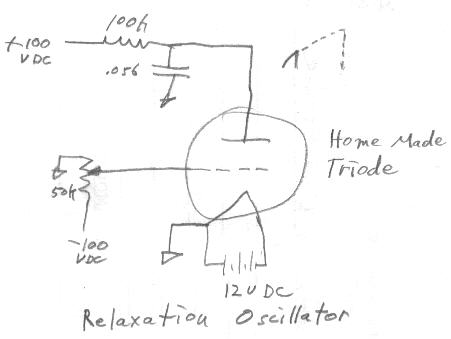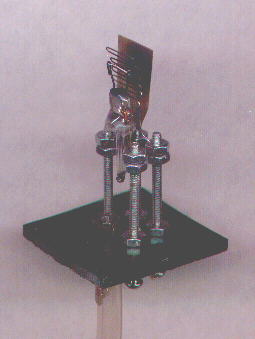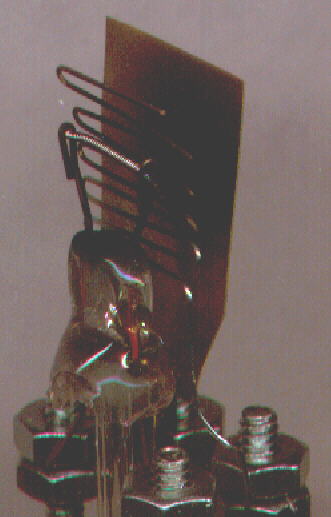


This is my first attempt at making a completely from scratch homemade vacuum tube triode. There is not much more to say about the construction than what the picture says. The filament is from a car turn signal lamp, the grid is a piece of steel wire bent as shown and the plate is a piece of thin brass that was handy. They are all mounted with the screws shown. The screws are connected through a flat piece of ABS plastic and sealed on the outside with hot glue. A rubber gasket is laid on the plate around the outside and a small bell jar (actually a glass salt shaker) is set over the whole assembly before evacuating.
The triode was first tested on an old Tektronix 575 curve tracer. As with the homemade diode mentioned previously, it was necessary to apply almost the full 12 volts to the filament in order to get any action. Commercial vacuum tubes use some kind of thorium treated filaments which allow them to emit electrons at a much lower temperature. This filament, being just plain tungsten, had to be near its normal incandescent temperature in order to emit electrons. With the filament connected to a 12 volt battery, Tungsten seems to emit electrons very well; you just have to run it at a higher temperature. The higher temperature, however, does seem to create an additional situation as I will try to theorize and explain below.
This homemade triode seems to be able to operate in two different modes. It can conduct current from the filament to the plate through hot filament electron emission or, through ionization of the residual air. When conducting through filament emission, it tends to behave like a normal amplifying triode where the plate current is controlled by a voltage applied to the grid. When conducting through ionized air, it acts more like a thyratron where the grid only controls the ionization breakdown voltage. Because the tungsten filament is running much hotter (near or at full incandescence), than a normal vacuum triode thoriated filament, the heat or brightness (Iam not sure which), brings the residual air close to ionization. This gives the tube a greater tendacy to behave like a thyratron.
It seems capable of behaving like a normal amplifying triode only at a plate current of about 20 microamps and less when the filament is run at a lower temperature. The plate current can be controlled with varying amounts of negative grid voltage. This tube did not seem to respond as much to positive grid voltages as did the home evacuated factory made vacuum tube. The point between where the filament is just hot enough to cause electron emission and the point where it is so hot as to cause air ionization defines a small window where the tube can operate at as a normal amplifying triode. Future attempts will be to make this window of operation bigger. I believe that the homepumped factory made triode worked better in this mode because its thoriated filament was emitting electrons at a lower temperature where the air was not so easy to ionize. I want to try to optimise this window of operation with the homemade vacuum triode.
The thyratron action worked very well and could carry much more plate current - in the many milliamp range. Ionization (breakdown) voltages between the filament and the plate could be adjusted all the way from about 25 up to the 100 applied plate volts by varying the grid voltage from zero to minus 35 volts. The Ionizing voltage was greatest with the grid at negative 35 volts.

I will point out that with up to 200 volts applied to the plate, no reverse current was observed during all of the experimentation. This was easy to check since I have modified the Tektronix 575 curve tracer to be able to apply ac voltages across its devices udner test. This means that it is easy to make a vacuum diode rectifier no matter what mode is used.
The tube was evacuated in the same way as the previous experiments using the two shage Robinair vacuum pump. Most of the experimenting was done at a vacuum of about 10 microns or below. The thyratron action seemed to work well however, up to 50 microns. I didn't operate the tube at much higher pressures in order to prolong the life of the filament.